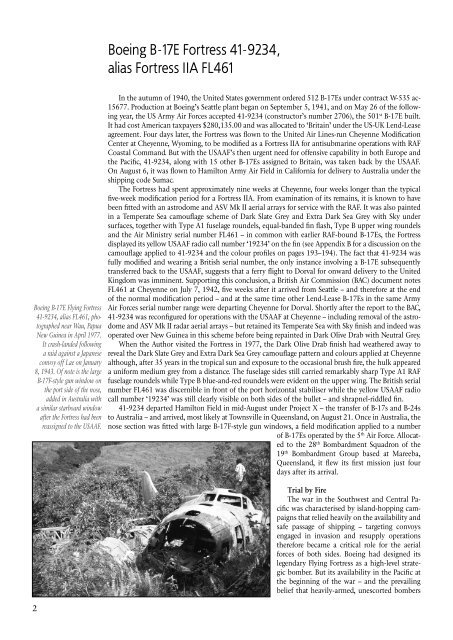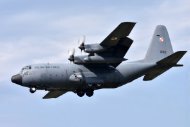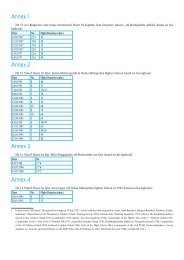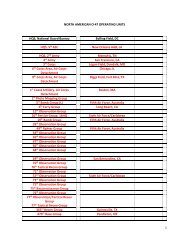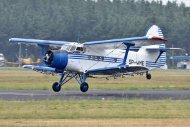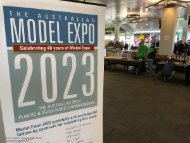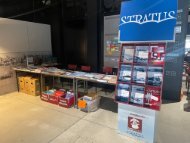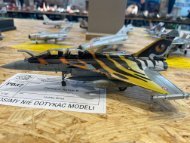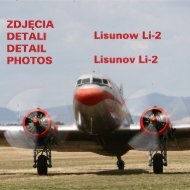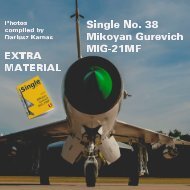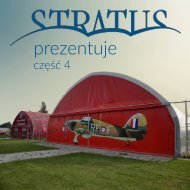B-17 CC Additional Material by Robert M Stitt
Boeing B-17 Fortress in RAF Coastal Command Service Second Edition Robert M Stitt Additional Material
Boeing B-17 Fortress in RAF Coastal Command Service
Second Edition
Robert M Stitt
Additional Material
- No tags were found...
Create successful ePaper yourself
Turn your PDF publications into a flip-book with our unique Google optimized e-Paper software.
Boeing B-<strong>17</strong>E Fortress 41-9234,<br />
alias Fortress IIA FL461<br />
Boeing B-<strong>17</strong>E Flying Fortress<br />
41-9234, alias FL461, photographed<br />
near Wau, Papua<br />
New Guinea in April 1977.<br />
It crash-landed following<br />
a raid against a Japanese<br />
convoy off Lae on January<br />
8, 1943. Of note is the large<br />
B-<strong>17</strong>F-style gun window on<br />
the port side of the nose,<br />
added in Australia with<br />
a similar starboard window<br />
after the Fortress had been<br />
reassigned to the USAAF.<br />
In the autumn of 1940, the United States government ordered 512 B-<strong>17</strong>Es under contract W-535 ac-<br />
15677. Production at Boeing’s Seattle plant began on September 5, 1941, and on May 26 of the following<br />
year, the US Army Air Forces accepted 41-9234 (constructor’s number 2706), the 501 st B-<strong>17</strong>E built.<br />
It had cost American taxpayers $280,135.00 and was allocated to ‘Britain’ under the US-UK Lend-Lease<br />
agreement. Four days later, the Fortress was flown to the United Air Lines-run Cheyenne Modification<br />
Center at Cheyenne, Wyoming, to be modified as a Fortress IIA for antisubmarine operations with RAF<br />
Coastal Command. But with the USAAF’s then urgent need for offensive capability in both Europe and<br />
the Pacific, 41-9234, along with 15 other B-<strong>17</strong>Es assigned to Britain, was taken back <strong>by</strong> the USAAF.<br />
On August 6, it was flown to Hamilton Army Air Field in California for delivery to Australia under the<br />
shipping code Sumac.<br />
The Fortress had spent approximately nine weeks at Cheyenne, four weeks longer than the typical<br />
five-week modification period for a Fortress IIA. From examination of its remains, it is known to have<br />
been fitted with an astrodome and ASV Mk II aerial arrays for service with the RAF. It was also painted<br />
in a Temperate Sea camouflage scheme of Dark Slate Grey and Extra Dark Sea Grey with Sky under<br />
surfaces, together with Type A1 fuselage roundels, equal-banded fin flash, Type B upper wing roundels<br />
and the Air Ministry serial number FL461 – in common with earlier RAF-bound B-<strong>17</strong>Es, the Fortress<br />
displayed its yellow USAAF radio call number ‘19234’ on the fin (see Appendix B for a discussion on the<br />
camouflage applied to 41-9234 and the colour profiles on pages 193–194). The fact that 41-9234 was<br />
fully modified and wearing a British serial number, the only instance involving a B-<strong>17</strong>E subsequently<br />
transferred back to the USAAF, suggests that a ferry flight to Dorval for onward delivery to the United<br />
Kingdom was imminent. Supporting this conclusion, a British Air Commission (BAC) document notes<br />
FL461 at Cheyenne on July 7, 1942, five weeks after it arrived from Seattle – and therefore at the end<br />
of the normal modification period – and at the same time other Lend-Lease B-<strong>17</strong>Es in the same Army<br />
Air Forces serial number range were departing Cheyenne for Dorval. Shortly after the report to the BAC,<br />
41-9234 was reconfigured for operations with the USAAF at Cheyenne – including removal of the astrodome<br />
and ASV Mk II radar aerial arrays – but retained its Temperate Sea with Sky finish and indeed was<br />
operated over New Guinea in this scheme before being repainted in Dark Olive Drab with Neutral Grey.<br />
When the Author visited the Fortress in 1977, the Dark Olive Drab finish had weathered away to<br />
reveal the Dark Slate Grey and Extra Dark Sea Grey camouflage pattern and colours applied at Cheyenne<br />
although, after 35 years in the tropical sun and exposure to the occasional brush fire, the hulk appeared<br />
a uniform medium grey from a distance. The fuselage sides still carried remarkably sharp Type A1 RAF<br />
fuselage roundels while Type B blue-and-red roundels were evident on the upper wing. The British serial<br />
number FL461 was discernible in front of the port horizontal stabiliser while the yellow USAAF radio<br />
call number ‘19234’ was still clearly visible on both sides of the bullet – and shrapnel-riddled fin.<br />
41-9234 departed Hamilton Field in mid-August under Project X – the transfer of B-<strong>17</strong>s and B-24s<br />
to Australia – and arrived, most likely at Townsville in Queensland, on August 21. Once in Australia, the<br />
nose section was fitted with large B-<strong>17</strong>F-style gun windows, a field modification applied to a number<br />
of B-<strong>17</strong>Es operated <strong>by</strong> the 5 th Air Force. Allocated<br />
to the 28 th Bombardment Squadron of the<br />
19 th Bombardment Group based at Mareeba,<br />
Queensland, it flew its first mission just four<br />
days after its arrival.<br />
Trial <strong>by</strong> Fire<br />
The war in the Southwest and Central Pacific<br />
was characterised <strong>by</strong> island-hopping campaigns<br />
that relied heavily on the availability and<br />
safe passage of shipping – targeting convoys<br />
engaged in invasion and resupply operations<br />
therefore became a critical role for the aerial<br />
forces of both sides. Boeing had designed its<br />
legendary Flying Fortress as a high-level strategic<br />
bomber. But its availability in the Pacific at<br />
the beginning of the war – and the prevailing<br />
belief that heavily-armed, unescorted bombers<br />
2


